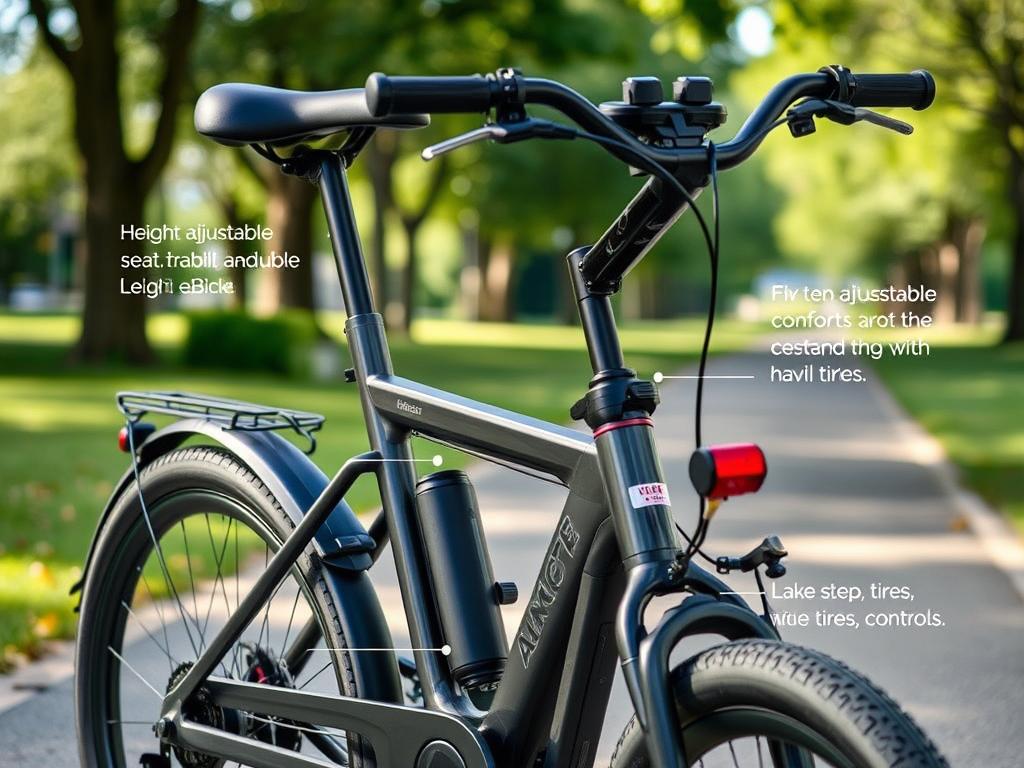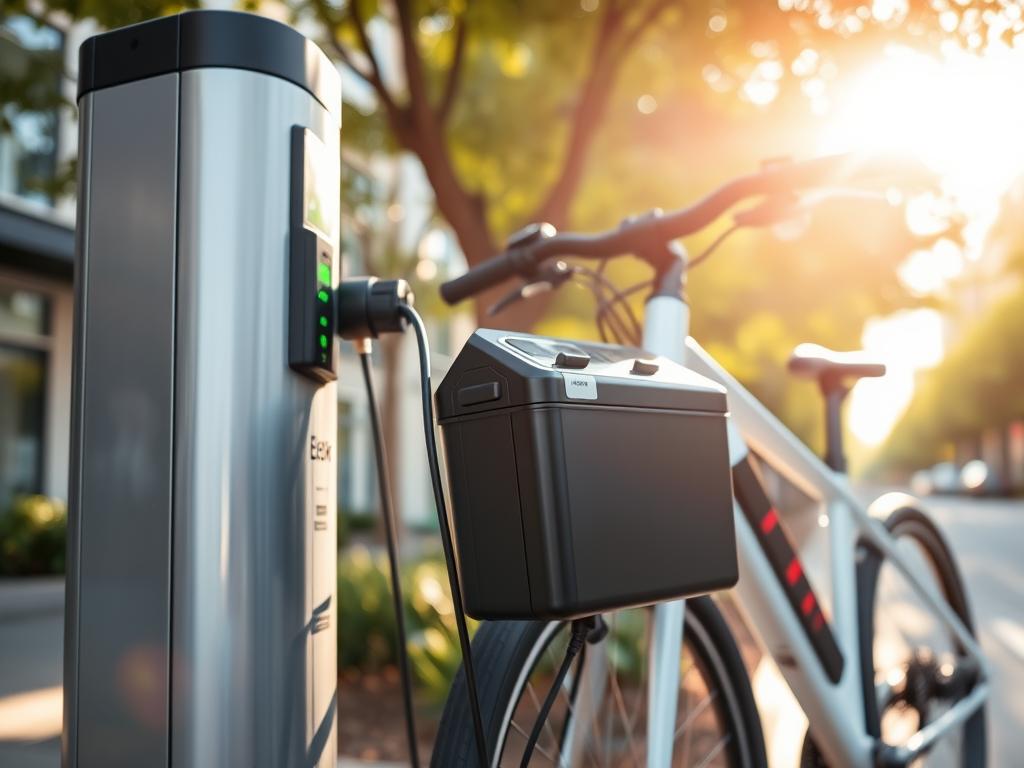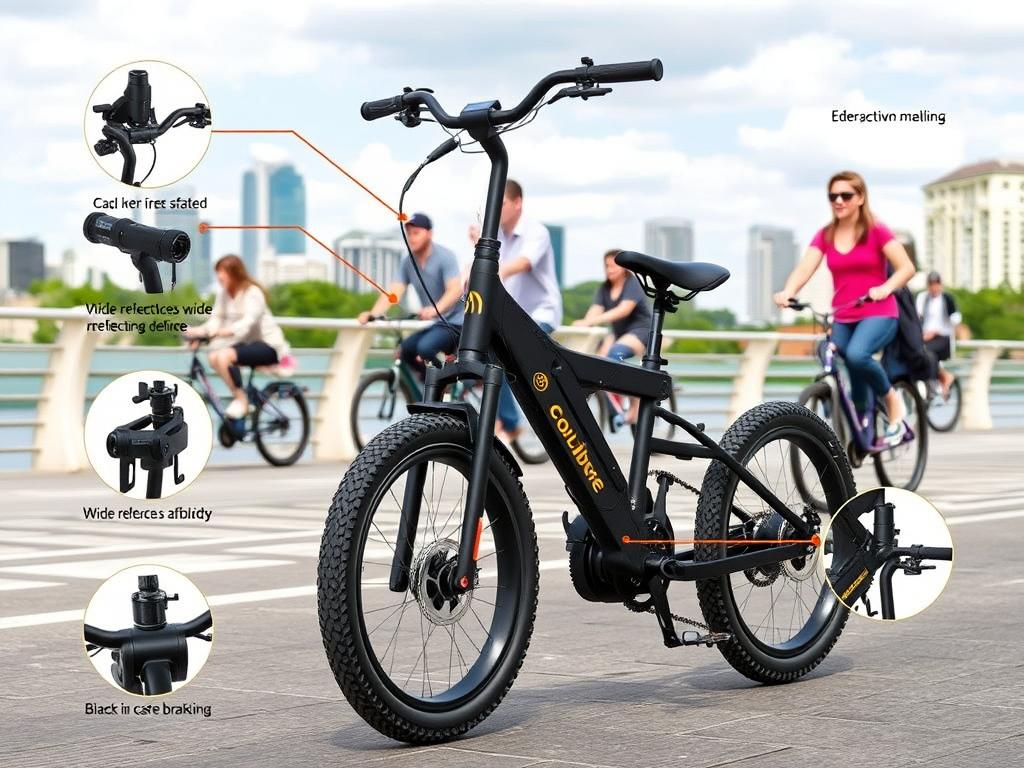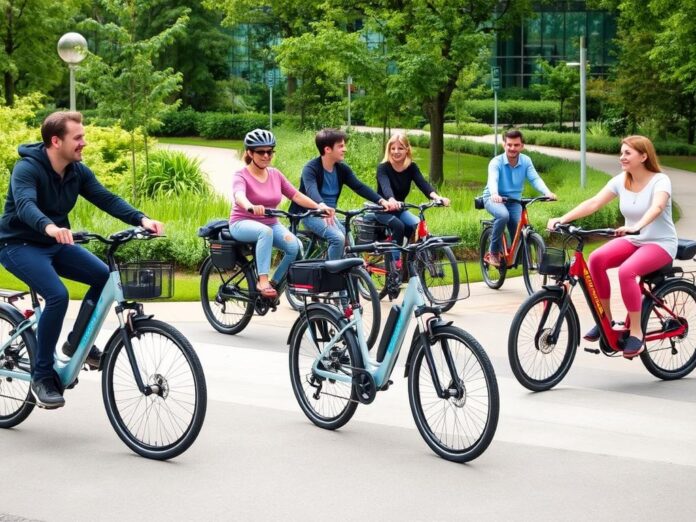Adaptive eBikes are changing the game for people with disabilities. They offer special bikes that meet different needs, letting everyone ride. These bikes have wheelchair access, electric motors, and can be customized to fit your needs.
They help improve mobility and independence. Adaptive bikes are a big step forward in sports technology. They offer benefits like better range of motion, improved motor skills, and better fitness.
The ebikesus.com website has a detailed guide on adaptive eBikes. It covers features like low step-through frames, adjustable seats, and easy controls. These bikes are made for various disabilities and preferences.
They also come with strong motors, long-lasting batteries, and can handle tough terrains. This means riders can confidently explore the outdoors.
Key Takeaways
- Adaptive eBikes offer accessibility and inclusivity for cyclists with diverse physical needs.
- These specialized bikes feature customizable designs, electric motors, and advanced technology to enhance mobility and independence.
- Adaptive eBikes provide therapeutic benefits such as improved range of motion, motor planning skills, and overall fitness.
- The ebikesus.com website offers a comprehensive guide to the features and benefits of adaptive eBikes.
- Adaptive eBikes are designed with low step-through frames, adjustable seating, and intuitive controls to cater to a wide range of users.
Understanding Adaptive eBikes
Adaptive eBikes are special bikes for people with disabilities or physical challenges. They come in many types to meet different needs. This includes handcycles, recumbent bikes, tricycles, and hybrid models. These bikes make cycling accessible for everyone.
What Are Adaptive eBikes?
Adaptive eBikes are designed for specific needs. Handcycles use the arms to move, while recumbent bikes offer a comfy, laid-back seat. Tandem bikes are for two riders, and hybrid bikes mix features for a full-body workout.
Importance of Accessibility in Biking
Adaptive eBikes make biking open to everyone. They let people with disabilities enjoy the outdoors, stay healthy, and feel the joy of biking. These bikes help riders be more independent and active.
| Key Adaptive eBike Features | Benefits for Riders |
|---|---|
| Customizable controls and stabilization systems | Increased safety, comfort, and ease of use |
| Accessibility-focused design (e.g., low step-through frames) | Improved mobility and independence |
| Powerful motors and extended battery life | Extended range and endurance for longer rides |
The future of adaptive eBikes looks bright. New tech will help more people with disabilities enjoy biking. As things improve, biking will become more welcoming for everyone.
Key Features for Enhanced Accessibility
Adaptive eBikes come with special features for riders with different needs. They make sure cycling is comfortable and easy for everyone. These features help people with various physical challenges to ride with ease.
Low Step-Through Frames
Adaptive eBikes have low step-through frames. This makes it easy to get on and off the bike, especially for those with mobility issues. The design helps avoid the strain of traditional bikes.
Adjustable Seat Heights
These eBikes have seats that can be adjusted to fit any body type. Riders can change the seat height to find the most comfortable spot. This helps avoid back, hip, and knee pain.
Intuitive Controls
The controls on these eBikes are easy to use. They have special handlebars, simple brakes, and big screens. These features help riders with vision or hand issues to ride confidently.
Together, the low step-through frames, adjustable seats, and easy controls make eBikes more accessible. These ergonomic ebike adaptations and adjustable ebike features let people with different needs enjoy riding.
“Adaptive eBikes have truly transformed the cycling landscape, opening up a world of possibilities for individuals with varying physical abilities.”

Motor Power and Performance
Adaptive electric bikes (eBikes) for the disabled rely heavily on the motor for a good ride. They use different motor types to meet the needs of various riders.
Types of Motors for Adaptive eBikes
Hub motors are found in the front or rear wheel, making them compact and simple. Mid-drive motors are near the pedals, giving a natural feel and better balance.
Motor Assistance Levels
Adaptive eBikes have different motor assistance levels. These include low, medium, and high. Riders can adjust the power to fit their needs and the terrain. This helps reduce fatigue and makes commuting eco-friendly for those with electric bikes for disabled or mobility issues.
The motors work with features like cadence and torque sensors. This ensures the motor responds well to the rider’s pedaling. Smart tech, like Bluetooth and apps, adds features like navigation and gear shifting, making the ride better.
| Motor Type | Key Features | Ideal for |
|---|---|---|
| Hub Motor | – Compact and straightforward design – Integrated into the front or rear wheel |
Riders seeking a simple, easy-to-maintain motor solution |
| Mid-Drive Motor | – Natural feel and improved weight distribution – Situated near the pedals |
Riders looking for a more responsive and dynamic riding experience |
“The motor assistance levels in adaptive eBikes are a game-changer for riders with disabilities, allowing them to tailor the power output to their individual needs and ride with confidence.”
Knowing about the motors and adjustable levels helps those with mobility challenges find the right electric bikes for disabled. This empowers them to explore freely and independently.
Battery Life and Charging
Adaptive eBikes rely on battery capacity for their range and ride time. The eBike battery life changes based on the rider’s weight, terrain, and pedal assist level.
Battery Capacity Considerations
The 52V 13Ah Li-ion battery powers the rear hub motor up to 500 rpm for up to 3 hours. The AFPM alternator boosts ebike battery life by not using the motor for power.
Charging Options for Convenience
Adaptive eBikes make charging easy. Some have removable batteries for indoor or on-the-go charging. This is great for daily users, ensuring their bike is always ready.
The COVID-19 pandemic has led to more people using e-bikes for daily commutes. Adaptive e-bikes are affordable and accessible, unlike traditional public transport.
| Battery Capacity | Range | Speed |
|---|---|---|
| 52V 13Ah Li-ion | Up to 3 hours | Max 500 rpm |
| Standard e-bike | 30-60 km | 25 km/h |
| Advanced e-bike | 90-120 km | 45 km/h |
Charging through pedaling saves on electricity costs. With fuel prices rising, more people are choosing e-bikes with power pedal assist.

“The inclusion of electromagnetic brakes in the e-bikes acts as an anti-theft system, securing the bike when not in use.”
Customizability and Accessories
Adaptive eBikes are all about making each ride personal. They’re built to fit the needs of every rider, ensuring a ride that’s both comfy and easy to get around on. One cool thing about these bikes is how they can be set up with different seats for various body types.
For wheelchair users, these eBikes have special mounts. This means you can hop on and ride without having to move your chair around. You can also add things like headrests, footrests, and special handlebars to make your ride even better.
Tailoring the Ride to Your Needs
Adaptive eBikes can be adjusted to fit you perfectly. This makes sure you’re safe, comfy, and can enjoy the ride, no matter your physical abilities. You can pick from many types, like tricycles, tandems, and handcycles, to find what works best for you.
There are also cool extras like special seats and cushions to help you stay comfy. These features make adaptive eBikes great for staying active and connecting with others.
Need more support or a certain riding style? Adaptive eBikes have lots of customizable ebike options and adaptive bike accessories for you. They offer freedom and independence like no other.
Safety Features for All Rides
Adaptive eBikes are made with safety in mind. They offer a secure and fun ride for everyone. They have integrated lighting systems that make riders visible in the dark.
These lights help riders see and be seen during early morning, evening, or night rides. This makes the roads safer for everyone.
Adaptive eBikes also have reflective surfaces and safety indicators. These features make riders more visible to drivers and pedestrians. This reduces the chance of accidents and makes cycling safer for all.
Manufacturers focus on safety in adaptive eBikes. They add features like wider tires, better brakes, and sounds for the visually impaired. These features make cycling safer and more accessible for everyone.
Integrated Lighting Systems
Adaptive eBikes have lights that make riders visible in the dark. These lights help prevent accidents and make cycling safer.
Reflective Surfaces and Safety Indicators
Adaptive eBikes also have reflective surfaces and safety indicators. These features help alert others to the rider’s presence. This ensures riders are respected and recognized on the road.
| Safety Feature | Benefit |
|---|---|
| Integrated Lighting Systems | Improved visibility in low-light conditions, reducing the risk of accidents |
| Reflective Surfaces and Safety Indicators | Enhanced visibility to other road users, promoting safer shared spaces for cyclists |
| Wider Tires for Stability | Improved stability and control, especially for riders with limited mobility |
| Advanced Braking Systems | Reliable and responsive braking, ensuring a safer riding experience |
| Audible Signals for Visually Impaired Riders | Alerting riders with visual impairments to their surroundings, enhancing their safety and independence |

“72% of disabled riders find customizable controls on electric bikes extremely beneficial.”
– National Center for Biotechnology Information
Adaptive eBike makers focus on safety to let all riders enjoy cycling. These safety features are key to making cycling safe and accessible for everyone. They help more people experience the freedom and independence of adaptive eBikes.
Terrain Adaptability
All-terrain adaptive ebikes are great at handling different places. They can go from city streets to off-road trails easily. This is thanks to strong frames, special tires, and advanced suspension.
All-Terrain Capability Explained
Adaptive ebikes have special features for different terrains. They have wide, knobby tires for grip on rough surfaces. Front and rear suspension systems help smooth out bumps.
The bike’s design also helps with balance and control. This makes them good for both city and trail riding.
Suspension Systems for Smooth Rides
Suspension systems are key for a comfy ride on adaptive ebikes. They use air or coil springs to soak up shocks. This makes the ride smooth.
Riders can adjust these settings to fit their needs. This makes the ride even better for everyone.
| Feature | Benefit |
|---|---|
| Wide, Knobby Tires | Improved traction and stability on various surfaces |
| Front and Rear Suspension | Absorb shocks and vibrations for a smooth, comfortable ride |
| Adjustable Suspension Settings | Customized to individual rider’s needs and preferences |
Adaptive ebikes let riders with disabilities or mobility challenges explore more. They can safely and comfortably ride in different places. This opens up new chances for fun and freedom outdoors.
Smart Technology Integration
Modern adaptive ebikes come with smart tech that makes riding better for people with disabilities. They have GPS and mobile app features. These help disabled cyclists ride freely and confidently.
GPS Navigation Features
GPS on adaptive ebikes is a big help for riders with cognitive or visual issues. It lets them plan routes and get directions. This keeps their rides safe and easy.
The GPS also gives updates on the terrain and any obstacles. This helps riders make smart choices and ride smoothly.
Mobile App Connectivity
Adaptive ebikes with mobile apps offer a great riding experience. The app shows ride stats, battery life, and when to do maintenance. This lets riders keep an eye on their ebike and plan better.
Smart tech in adaptive ebikes is changing how disabled cyclists ride. It makes riding easier and more fun. Features like GPS and mobile apps help riders explore with confidence.
| Feature | Benefit |
|---|---|
| GPS Navigation | Assists riders in route planning and navigation, particularly beneficial for those with cognitive or visual impairments. |
| Mobile App Connectivity | Allows for easy tracking of ride statistics, battery life, and maintenance schedules, providing a more integrated and informative cycling experience. |
Choosing the Right Adaptive eBike
Finding the right adaptive eBike is key for a great ride. Think about your disability, physical abilities, how you plan to use it, and where you’ll ride. These factors help pick the best eBike for you.
Factors to Consider
Look at the frame type, motor power, battery life, and customization options. Think about what you need, like a low step-through or adjustable seat. Make sure the eBike’s power and battery meet your riding needs.
Test Riding for the Best Fit
It’s vital to test ride an adaptive eBike. Try out different models to find the perfect fit. This way, you can choose the adaptive eBike that fits your ebike fitting for disabilities needs best.
The right eBike can change your life. It lets you explore, commute, and enjoy the outdoors more easily. By considering these factors and test riding, you’ll find the ideal eBike for you.
Maintenance and Care for Your eBike
Keeping your adaptive eBike in good shape is key for its long life and best performance. Regular checks and proper care can greatly extend your eBike’s life. It’s important to manage the battery and check the motor regularly.
Regular Check-ups and Services
Getting your eBike checked by a pro can spot problems early. They’ll look at the battery, motor, and more. Taking good care of the battery helps it last longer, usually two to five years.
Tips for Long-Lasting Performance
To keep your eBike running well, follow these tips: Clean and lubricate it regularly. Store it dry and safe when not riding. Remember, it can carry riders up to 250 lbs (113 kg). These steps help your eBike stay reliable and fun for years.






